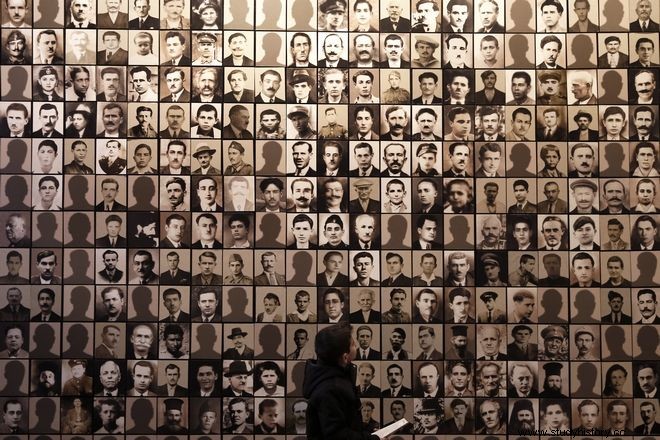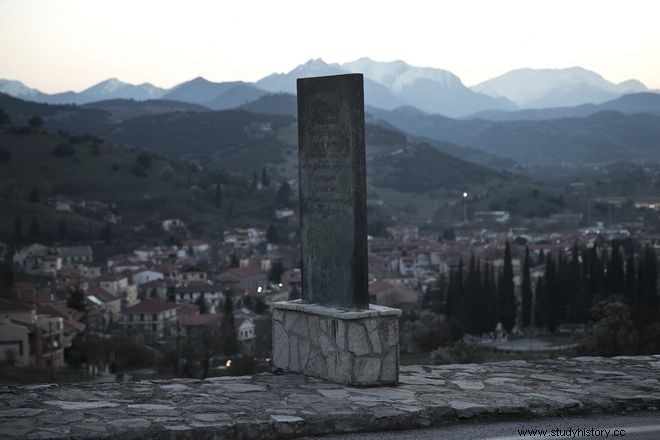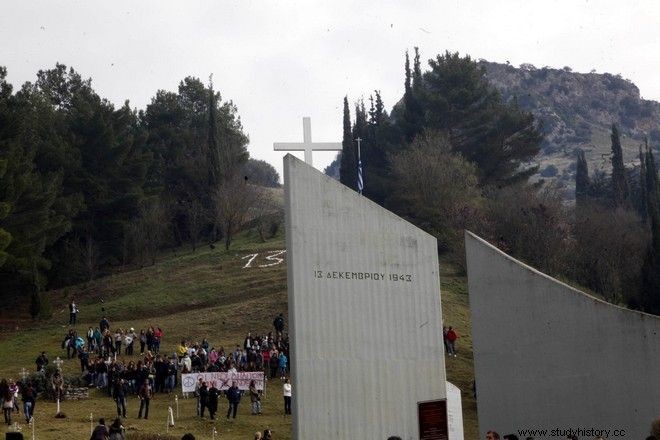One of the biggest crimes of Nazi Germany during World War II. On December 13, 1943, "Wehrmacht" forces killed almost all the male inhabitants of Kalavryta, in retaliation for the execution of captured German soldiers by ELAS.
According to Sansimera.gr, especially in the last year of the Occupation, the extremes of the conquerors had increased dramatically, as their sovereignty was constantly challenged by the Greek resistance and their forces were not sufficient to control the country. The fate of Kalavryta seems to have been predetermined during the defeat of the Germans by the ELAS forces in the Battle of Kerpini (October 20, 1943), during which dozens of German soldiers were killed and 78 were captured.
The field of the Battle of Kerpini from above:
Then the "Operation Kalavryta" ("Unternehmen Kalavryta") was implemented by the German headquarters, with the objective of encircling the rebels in the mountainous area of Kalavryta and exterminating them. The execution of the mission was undertaken by units of the 117th Fighter Division, based in the Peloponnese and led by Major General Carl von Le Zuir (1898-1954).
The aristocratic German general, having learned of the execution of 78 German prisoners by the rebels, ordered his men not to hesitate to take the harshest reprisals against the civilian population of the area. It was, after all, the occupation authorities' practice to execute multiple Greek civilians for every German soldier killed.

"Operation Kalavryta" began on December 4, when German forces began to converge on the wider area of Kalavryta from Patras, Aigio, Pyrgos and Tripoli. In their path they burned villages and monasteries (Mega Spilaio and Agia Lavra) and killed unarmed citizens and monks.
On December 9, they reached Kalavryta, creating a suffocating cordon around the city. They reassured the residents, assuring them that their goal was solely to exterminate the rebels and even asked those who had left it to return fearlessly back to Kalavrita. To convince them even more, they proceeded to set fire to houses belonging to insurgents, and sought the fate of the German wounded from the battle of Kerpini.

Suddenly, however, on the morning of Monday, December 13, they gathered the entire population in the central square and led the male population over the age of 13 to a sloping location, called "Rachi tou Kapi", while the female children were locked in the school. On the ridge of Kapi, the tragedy unfolded in the first afternoon hours, which led to the death of almost the entire male population of Kalavryta. With bursts of machine guns, the Germans executed the gathered, around 800 people. Only 13 Kalavrytians were saved and they were covered by the corpses of their fellow citizens and the Germans considered them dead. The signal for the execution was given with a flare from the center of Kalavryta by Major Hans Ebersberger and the head of the execution squad was Lieutenant Williband Akamphuber.
The crime ended with the burning of almost all the houses of Kalavryta. As for the fate of the women and children, they were saved thanks to the humanity of an Austrian soldier, who had been entrusted with their care. He left the entrance to the school free and facilitated their removal. But he paid for it with his life, after he was sentenced to death and executed.

In total, during "Operation Kalavryta", the Germans killed 1,101 people, destroyed and looted over 1,000 houses, confiscated 2,000 sheep and goats, and seized 260,000,000 drachmas.
None of those responsible for the Holocaust of Kalavryta were held accountable to Justice. General Le Juir died as a prisoner of the Soviets in 1954, Ebersberger was killed on the Eastern Front and Akamphuber died in Austria in 1972, aged 67.
Only the occupying military commander of Greece, General Helmut Felmi (1885-1965), was sentenced in 1948 to 15 years in prison by the Nuremberg Tribunal for all Third Reich war crimes in Greece, but was released after three years. On April 18, 2000, the then President of the Federal Republic of Germany, Johannes Rau (1931-2006), visited Kalavrita and expressed his deep sorrow for the tragedy. However, he did not take responsibility on behalf of the German state and did not address the issue of reparations.
The battle of Kerpini
About the Battle of Kerpini, we read in the book of Ilias Papastergiopoulos:"O Morias in Arms" (volume D). The relevant passage was retrieved from katiousa.gr.
As described by Komninos Pyromaglou (educator, Resistance fighter, co-founder of the EDES organization during the years of occupation, politician and writer):
"After the complete occupation, by the Allied Armies, of Southern Italy, as well as the liberation of North Africa, the Peloponnese and the Western Continent were considered by the German Staff "as the first front line", in the rear of which all insurgents should be neutralized movements "if necessary to depopulate the area". The German Staff, fearing the occupation of Iptanisos, and landings on the western coast of Greece (after all, such an allied action was expected) decided to act not only in liquidation operations against the Greek rebels, but also to pass through fire and iron the inhabitants and villages of the mountainous region of Greece...

...The massacres and massacres of Kalavryta were not an isolated act of the Germans. It was one of the actions of a more general plan of the German Staff, at the expense of the civilian Greek population. Isolation of the drama of Kalavryta betrays, we think, deliberate deception or deliberate exploitation. The destruction and massacre of Kalavryta took place on December 13, 1943, and the execution of the German prisoners took place on the night of December 13, 1943. (pp. The Germans confess that the execution of the German prisoners took place on 12/17/43 )"...
...There is also the Declaration of the Germans of the Peloponnese:"On 17.12.1943, German soldiers were brutally murdered and mutilated by communist gangs in the area of Kalavryta - Mazeiko".
As mentioned in the book in question, Kalavryta was destroyed on 13/12/1943. And the Germans themselves report that their soldiers were killed on 12/17/43, i.e. after four days...
...The Germans used the execution of Nazi soldiers as a pretext for their premeditated crimes. (...) The impression caused by this massacre on the Greek people was astonishment, anger and indignation. Abroad, great forces of world public opinion were mobilized against the Hitlerites not only in allied countries, but also in neutral countries. This unimaginable crime was stigmatized everywhere and remained as one of the most dishonorable stains of the Nazi regime.
And yet, 16 years later, in the Hellenic Parliament, there were people who tried to... justify this crime! In October 1959 (Parliament debates of 20, 21 and 22 October 1959), the then vice-president of the government, P. Kanellopoulos, speaking about the events of Kalavryta, said that they were caused by the... justified anger and indignation of the Germans, because ELAS executed German prisoners. The same was supported a few months earlier by ERE MP V. Paparrigopoulos.
To the two politicians, who placed the massacre of Kalavryta at a level where even the Germans had not dared to place it before, the deputy leader of EDES, Komninos Pyromaglou, gave a mouth-watering answer to the journalistic organ of the National Resistance Organizations, "Historical Archive of National Resistance". revealing that the massacre of the Kalavritas preceded the execution of the German prisoners! The rebels had warned the Germans to stop the execution of hostages in Patras and Agios, because, otherwise, they would also be forced to execute German prisoners, which they had in their hands since the victorious battle of Kerpini...".
Commenting on the issue and the campaigner Evag. Macheiras writes in his memoirs: "The reprisals were not ordered, nor implemented after the execution of the prisoners, but before it. Before the execution, Kalavrita and twenty more villages were burned... Before the execution of the prisoners, about 1,000 were executed in Kalavrita and 300 approximately in the above villages and monasteries...".
You can read more about the historical research here, from the book by D. Kanellopoulos. According to him, the Nazis "surrendered" Sober's company to serve a diabolical plan that led to the premeditated massacre.
Follow News247.gr on Google News and be the first to know all the news.
